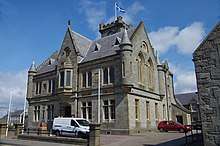Lerwick Town Hall
Lerwick Town Hall is a municipal building located in central Lerwick, Shetland, Scotland. It is protected as a Category A listed building.[1]
| Lerwick Town Hall | |
|---|---|
 Lerwick Town Hall | |
| Location | Lerwick |
| Coordinates | 60°9′16″N 1°8′46″W |
| Built | 1883 |
| Architect | Alexander Ross |
| Architectural style(s) | Scottish Baronial style |
Listed Building – Category A | |
| Designated | 8 November 1974 |
| Reference no. | 37256 |
 Shown in Shetland | |
History
The building was commissioned during a period of expansion in Lerwick due to the wealth the herring industry brought.[2] A site on the north Hillhead was selected.[2] It was designed by architect Alexander Ross of Inverness in the Scottish Baronial style and builder John M. Aitken of Lerwick won the tender competition with a price of £3,240.[2] The foundation stone was laid by Prince Alfred, Duke of Edinburgh on a visit to the isles on 24 January 1882.[2] That same evening Lerwick saw the first ever Up Helly Aa torchlight procession.[2] The building was officially opened by George Thoms, sheriff of Caithness, Orkney and Shetland, on 30 July 1883.[2]
The Corporation of Hamburg presented a stained glass window for the town hall in 1883[3] and the building was topped with a clock installed by Potts of Leeds in 1887.[4]
The town hall was the headquarters of Lerwick Town Council until 1975 and has been the home of the Shetland Islands Council since then.[5] The front steps, which had badly decayed, were replaced in spring 2008.[2]
Services
The town hall is used for functions such as marriages, wedding receptions, concerts, coffee mornings and evening events.[6]
References
- Historic Environment Scotland. "Lerwick Town hall, Hillhead and Charlotte Street, Including Lamp Standards, Gatepiers, Boundary Walls and Railings, Lerwick (Category A) (LB37256)". Retrieved 14 April 2020.
- "It cost £4,940 15/6d to build, now monument to civic splendour is 125 years old". The Shetland Times. Retrieved 14 April 2020.
- "The Hamburg Window". Shetland Council. Retrieved 14 April 2020.
- Potts, Michael (2006). Potts of Leeds – Five Generations of Clockmakers. Mayfield Books. p. 395. ISBN 0-9523270-8-2.
- "Shetland: a model for the future". The Shetland Times. 5 April 2013. Retrieved 14 April 2020.
- "Welcome to Shetland Islands Council". shetland.gov.uk. Archived from the original on 13 August 2006. Retrieved 20 January 2014.